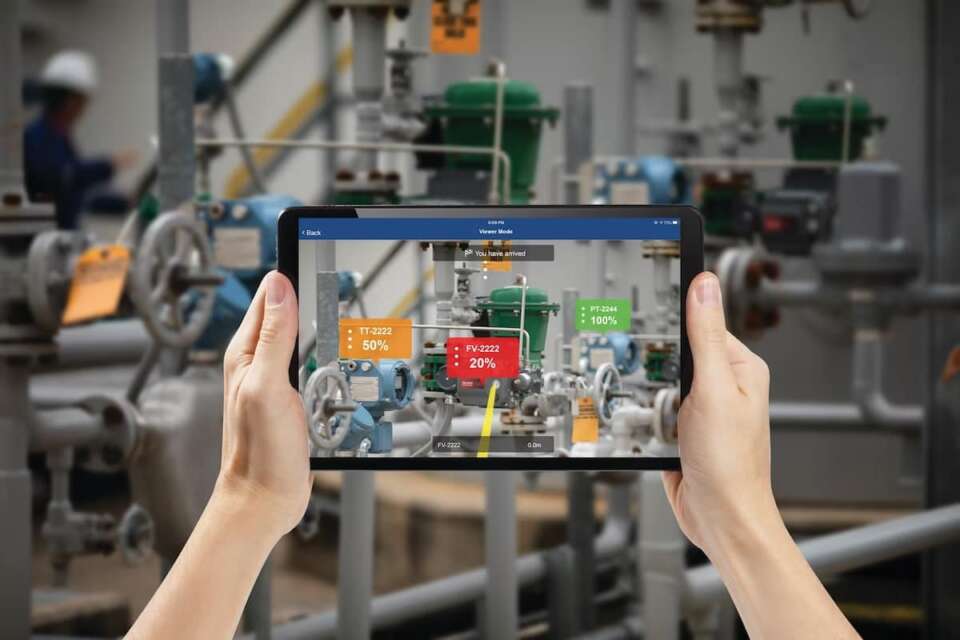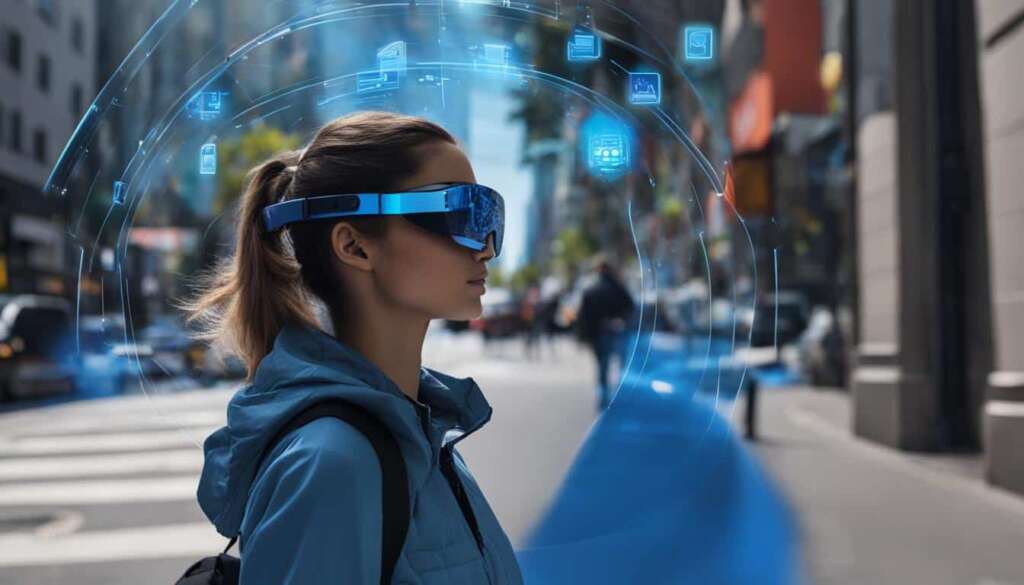Table of Contents
The Role of Augmented Reality (AR) in Today’s Business World is a subject that has garnered significant attention in recent years. As we navigate through the digital age, AR technology is no longer just a futuristic concept but a transformative business tool. It has found applications across various industries, from retail and healthcare to manufacturing and education, revolutionizing the way companies operate, engage with customers, and achieve competitive advantage.
Augmented Reality overlays digital information, such as images, videos, or sounds, onto the real world, offering an interactive and enhanced experience. This technology has the potential to redefine traditional business models, create new revenue streams, and offer solutions to complex problems.
In this article, we will delve into the multifaceted applications of AR in the business landscape, explore its benefits and challenges, and look at case studies that demonstrate its transformative power.
Applications Across Industries
The influence of AR technology is far-reaching, extending beyond mere novelty to become a transformative force in multiple sectors. Here’s a deeper look into some of the key industries where Augmented Reality is making a significant impact:
Retail and E-commerce
In the retail sector, AR is revolutionizing the customer experience. It allows shoppers to virtually try on clothes, accessories, or even visualize how furniture would look in their homes. This not only enhances customer engagement but also significantly reduces the rate of product returns.
Healthcare
In healthcare, AR technology is not just a tool but a lifesaver. Surgeons are using it for complex procedures, overlaying digital data onto the real world for more precise incisions. It’s also used in training medical students, providing them with an interactive and immersive learning experience.
Manufacturing
The manufacturing industry is leveraging Augmented Reality for various applications, from assembly line installations to maintenance and quality control. AR helps in visualizing complex machinery parts, reducing errors, and thereby increasing overall productivity.
Education
Educational institutions are increasingly adopting AR to make learning more interactive and engaging. From textbooks that come alive with 3D models to virtual field trips that offer real-world experiences, AR is transforming the educational landscape.
Real Estate
AR is also making strides in the real estate industry, offering virtual tours of properties and interactive 3D models. This helps both buyers and sellers in making informed decisions, saving time and resources.
Tourism and Hospitality
In the tourism sector, AR apps can overlay historical data or interesting facts over landmarks, enhancing the sightseeing experience. Hotels are using AR to provide virtual concierge services, making the guest experience more enjoyable.
For a more comprehensive understanding of Augmented Reality, you can visit its Wikipedia page.
Challenges and Limitations
While AR technology offers a plethora of benefits, it’s essential to acknowledge the challenges and limitations that come with its implementation. Here are some of the most significant hurdles:
Cost of Implementation
The initial investment required for AR solutions can be substantial, especially for small and medium-sized enterprises. This includes not only the cost of hardware and software but also the ongoing expenses for maintenance, updates, and specialized talent. For many businesses, this financial burden can be a significant barrier to entry.
Technical Limitations
Despite advancements, AR technology still faces technical limitations that can hinder its widespread adoption. Issues such as latency, battery life, and the need for robust internet connectivity can affect the performance and reliability of AR applications. Moreover, the hardware requirements for high-quality AR experiences are often beyond the capabilities of average consumer devices.
User Experience
Creating an intuitive and seamless user experience is a challenge that goes beyond just the technical aspects. Poorly designed AR applications can lead to user frustration, confusion, and ultimately, disengagement. The user interface must be easy to navigate, and the AR elements should integrate naturally with the real-world environment.
Data Privacy and Security
With Augmented Reality collecting vast amounts of data, including potentially sensitive information like location and user behavior, concerns about data privacy and security are inevitable. Ensuring the safe storage, transmission, and handling of this data is crucial to gain user trust and comply with data protection laws.
Regulatory Compliance
Different industries have varying regulatory requirements, and meeting these while implementing AR solutions can be complex. For example, healthcare applications may need to comply with patient confidentiality rules, while retail applications might have to adhere to consumer protection laws. Navigating this regulatory landscape requires thorough planning and legal consultation.
Social and Ethical Concerns
The use of AR technology also raises social and ethical questions, such as the potential for misuse or the creation of deepfake content. These concerns necessitate ethical guidelines and governance structures to ensure responsible usage.
The Future of AR Technology
As we look ahead, it’s clear that AR technology is poised for significant growth and could fundamentally change the way we interact with the world around us. Here are some areas where we can expect to see advancements:
Integration with Other Technologies
One of the most exciting prospects is the integration of AR with other emerging technologies like Artificial Intelligence, Internet of Things, and 5G connectivity. This will enable more intelligent and responsive AR experiences. For example, integrating AR with AI could allow for real-time data analysis and decision-making, enhancing the utility and efficiency of AR applications.
Mainstream Adoption
While AR is already making waves in various industries, it has yet to achieve mainstream adoption. As technology improves and becomes more affordable, we can expect AR to become a part of our daily lives. The potential for AR to be integrated into social media platforms, educational systems, and even public services could drive its widespread acceptance.
Improved Hardware
The development of specialized AR glasses and headsets will provide users with more immersive experiences. Companies like Apple and Google are reportedly working on such devices. These hardware improvements could lead to lighter, more comfortable wearables with longer battery life, making AR more accessible and user-friendly.
Real-world Applications
Beyond gaming and entertainment, AR has the potential to solve real-world problems. For instance, it could be used in emergency response situations to provide real-time information to first responders. Imagine a firefighter being able to see the layout of a burning building through an AR headset, thereby improving the efficiency and safety of rescue operations.
Ethical and Regulatory Framework
As AR technology becomes more pervasive, there will be a need for a robust ethical and regulatory framework. This framework will likely involve multi-stakeholder cooperation, including governments, industry leaders, and civil society, to address issues like data privacy and potential misuse.
Sustainability and Environmental Impact
As with any technology, considerations about the environmental impact and sustainability of AR devices will become increasingly important. Manufacturers will need to look at the lifecycle of these products, from production to disposal, to ensure they meet sustainability standards.
Global Market Potential
The global market potential for AR technology is staggering and is expected to experience exponential growth in the coming years. According to various market research reports, the AR industry could be worth tens of billions of dollars by the end of the decade. This growth is not just a projection but is already being fueled by tangible factors such as:
Investment Influx
Venture capital firms, angel investors, and even governments are investing heavily in AR technology. This influx of capital is accelerating research and development, leading to more advanced and practical applications of AR.
Consumer Demand
The demand for AR experiences is rising among consumers, especially in sectors like gaming, education, and retail. For example, AR apps that allow virtual try-ons are becoming increasingly popular in the fashion industry.
Business Applications
Beyond consumer-oriented applications, businesses are also adopting AR for various purposes, including training, remote work, and product design. Industries like healthcare, automotive, and real estate are finding innovative ways to incorporate AR into their operations.
Technological Advancements
As technology continues to advance, especially in areas like machine learning, cloud computing, and data analytics, AR experiences are becoming more interactive, realistic, and useful.
Global Reach+
With the proliferation of smartphones and high-speed internet, AR technology is not limited to developed countries but is making inroads into emerging markets. This global reach multiplies the potential for AR’s growth and adoption.
For more insights into the future prospects of AR technology, you can read this Forbes article that delves into the current uses and future of AR.
Frequently Asked Questions (FAQs)
What is AR Technology?
AR Technology, or Augmented Reality Technology, is a digital innovation that overlays virtual elements onto the real world through a device, enhancing user interaction and experience.
How Does AR Technology Work?
AR technology works by using a range of sensors, cameras, and software to understand the physical environment and overlay relevant digital information or objects onto it.
What are the Applications of AR in Business?
AR technology has a wide range of applications in business, including training, product design, retail, and healthcare. It can improve efficiency, reduce costs, and enhance customer engagement.
What’s the Difference Between AR and VR?
While both AR and Virtual Reality (VR) are immersive technologies, AR adds to the real world, whereas VR creates a completely virtual environment.
How Secure is AR Technology?
Security is a significant concern for any digital technology, including AR. It’s crucial to follow best practices and security protocols to ensure the safe use of AR applications.
What is the Future of AR Technology?
The future of AR technology is promising, with advancements in hardware, software, and integration with other technologies. It is expected to become more pervasive in both consumer and business settings.
How Can I Get Started with AR?
Getting started with AR generally involves downloading an AR application on your smartphone or purchasing specialized AR hardware like glasses or headsets.
What are the Ethical Considerations in Using AR?
Ethical considerations include data privacy, user consent, and the potential for misuse of technology, among others.
Conclusion
In today’s rapidly evolving digital landscape, AR technology stands out as a transformative force with the potential to revolutionize how we interact with the world around us. From enhancing consumer experiences in retail and gaming to providing invaluable tools for various industries, the applications are as diverse as they are impactful. As we look to the future, the integration of AR with other emerging technologies, its mainstream adoption, and its global reach signal a trajectory of exponential growth and endless possibilities. While challenges such as security and ethical considerations remain, they are surmountable with the right frameworks and ongoing vigilance. As we continue to explore and understand this fascinating technology, one thing is clear: AR is not just a trend but a cornerstone of the next digital frontier.







